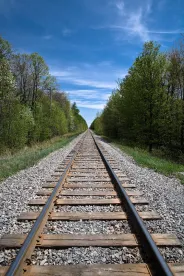Rail transport infrastructure is an essential component for the success of the Northern Powerhouse. The government vision for the future of the North’s rail system is clear – improved journey times and train frequencies that connect the main city regions and the North’s largest airport, with better connections to the wider network.
Spring 2016 saw Transport for the North publish an update of the Northern Transport Strategy – originally published in 2015 – identifying further progress on the long-term transport investment programmes, including in rail, road and associated schemes such as smart ticketing needed to deliver the key transport infrastructure elements of the Northern Powerhouse.
Following this, the government published its Northern Powerhouse Strategy in November 2016. The strategy confirmed a commitment to provide £13 billion in transport in the North over the course of its parliament, including approximately £1.2 billion for upgrading the existing rail franchises in the North and £60 million development funding for Northern Powerhouse Rail, the key rail project to improve connectivity between the cities of the North.
The intention? To invest in rail and other transport infrastructure to transform transport links that help re-balance the economy, drive the process of agglomeration and close the economic gap between the North and South, which on current figures is underpinned by a 25% productivity gap with the South.
Delivering
The investment plans of the government and key agencies such as Transport for the North are underpinned by several key strategic projects.
HS2 is set to become the backbone of the national railway network and will be a key element. Following the completion of Phases 2a and 2b, connectivity and journey times between the cities of the North, the Midlands and London will be transformed. It aims to improve journey times to Leeds by up to 50 minutes from London and 69 minutes from Birmingham. HS2, as a whole, is not just a new railway line – it is a wider economic  development project that will see, for example, new stations at Manchester Airport and in the centre of Manchester provide the focus for wider growth and regeneration, and transform connectivity with the wider network and other transport modes.
development project that will see, for example, new stations at Manchester Airport and in the centre of Manchester provide the focus for wider growth and regeneration, and transform connectivity with the wider network and other transport modes.
An additional key priority in the North is the Northern Powerhouse Rail project, sometimes referred to as HS3 or TransNorth. The long-term ambition is to link the economic centres of the North more closely so it can compete more effectively with the rest of the UK and international regions. Plans already under consideration include substantial upgrades to the lines between Leeds and Newcastle, and Leeds and Hull, as well as a vision to integrate a new line (between Manchester, Manchester Airport and Liverpool) with the planned HS2 infrastructure. Budget approval of £60 million was given for feasibility studies in 2016, and detailed plans are due to be published in 2017.
A focus on achieving “early wins” through upgrading existing services is also a key element of the government’s plans. New Northern and TransPennine franchises commenced operation in 2016. The franchises are now managed in the north in partnership between Rail North and the Department for Transport. This ground-breaking devolution decision is driving transformational investment in the region’s railways over the next five years. A £1.2 billion investment will see the introduction of some 500 brand new carriages across the franchises, electrification of lines and the removal of outdated trains, leading to an additional 2,000 services per week and 40,000 more passengers at peak travel times across the region. This is a signification step change from managed relative decline under previous franchises, to growth and investment franchises which will serve the entire north. It should also be noted that other investments in the region’s rail and metro networks continue to be made, with TfGM continuing to make significant investments in the Metrolink light rail system, and Merseytravel procuring a new rolling stock fleet. Other ongoing schemes include improvements to the existing TransPennine route, which will reduce journey times between Manchester and Leeds by 15 minutes, and the implementation of the Northern Hub scheme, which will significantly improve services around Sheffield, Liverpool and Manchester. Passengers on the East Coast Main Line serving destinations including Leeds, York and Newcastle will also benefit from the introduction of new rolling stock under the Intercity Express Project (IEP).
Supplementing these very significant developments is Smart North, a project which will deliver simplified fares, integrated ticketing and improved passenger information across the North It will allow passengers to travel quickly and easily on public transport around the North. This “tap-in, tap-out” system will enable rapid and seamless travel payment with a “fair-price promise” to ensure commuters get value travel and a real-time journey planning system to keep passengers on the move. The project is supported by £150 million awarded in the 2015 spending review and now has a clear implementation plan.
Away from passenger transport, key principles for action are the increase of rail the network capacity and resilience for freight, and the support of growth in strategically located rail freight interchanges and distribution centres.
Barriers to Success?
Taken as a whole, current and planned investment in the existing “classic” network and new projects such as Phases 2a and 2b of HS2 and Northern Powerhouse Rail represent the most significant and sustained programme of investment in the North’s rail network since the mid-20th century.
Delivery of this programme will not be without its challenges. The delivery of new UK infrastructure is subject to considerable challenges in relation to the obtaining of necessary consents and approvals, including parliamentary authorisations. A skills gap will present constraints in a context where a number of nationally significant infrastructure schemes are being delivered concurrently. Above all, clear and sustainable sources of funding and finance must be established in competition with other national schemes such Crossrail 2.
 However, it is arguable that, taken as a whole, the North is in a far better position to ensure delivery than at any time in the recent past. The importance of new transport infrastructure in addressing the productivity gap is now generally accepted; political reform such as the creation of combined authorities and directly elected mayors will establish broadly based democratic support for key projects; financial reform and innovation will hopefully underpin project finances; and the creation of key delivery bodies such as Transport for the North will ensure that the region is a better position to influence, control and deliver in this key area.
However, it is arguable that, taken as a whole, the North is in a far better position to ensure delivery than at any time in the recent past. The importance of new transport infrastructure in addressing the productivity gap is now generally accepted; political reform such as the creation of combined authorities and directly elected mayors will establish broadly based democratic support for key projects; financial reform and innovation will hopefully underpin project finances; and the creation of key delivery bodies such as Transport for the North will ensure that the region is a better position to influence, control and deliver in this key area.




 />i
/>i

